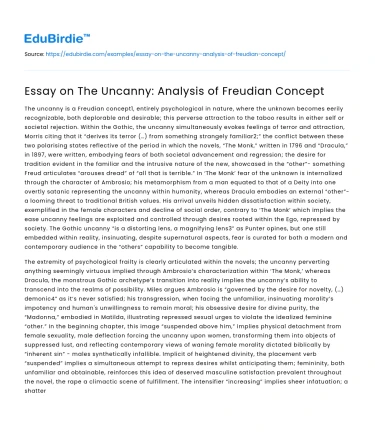The uncanny is a Freudian concept1, entirely psychological in nature, where the unknown becomes eerily recognizable, both deplorable and desirable; this perverse attraction to the taboo results in either self or societal rejection. Within the Gothic, the uncanny simultaneously evokes feelings of terror and attraction, Morris citing that it “derives its terror (…) from something strangely familiar2;” the conflict between these two polarising states reflective of the period in which the novels, “The Monk,” written in 1796 and “Dracula,” in 1897, were written, embodying fears of both societal advancement and regression; the desire for tradition evident in the familiar and the intrusive nature of the new, showcased in the “other”- something Freud articulates “arouses dread” of “all that is terrible.” In ‘The Monk’ fear of the unknown is internalized through the character of Ambrosio; his metamorphism from a man equated to that of a Deity into one overtly satanic representing the uncanny within humanity, whereas Dracula embodies an external “other”- a looming threat to traditional British values. His arrival unveils hidden dissatisfaction within society, exemplified in the female characters and decline of social order, contrary to ‘The Monk’ which implies the ease uncanny feelings are exploited and controlled through desires rooted within the Ego, repressed by society. The Gothic uncanny “is a distorting lens, a magnifying lens3” as Punter opines, but one still embedded within reality, insinuating, despite supernatural aspects, fear is curated for both a modern and contemporary audience in the “others” capability to become tangible.
The extremity of psychological frailty is clearly articulated within the novels; the uncanny perverting anything seemingly virtuous implied through Ambrosio’s characterization within ‘The Monk,’ whereas Dracula, the monstrous Gothic archetype’s transition into reality implies the uncanny’s ability to transcend into the realms of possibility. Miles argues Ambrosio is “governed by the desire for novelty, (…) demonic4” as it’s never satisfied; his transgression, when facing the unfamiliar, insinuating morality’s impotency and human's unwillingness to remain moral; his obsessive desire for divine purity, the “Madonna,” embodied in Matilda, illustrating repressed sexual urges to violate the idealized feminine “other.” In the beginning chapter, this image “suspended above him,” implies physical detachment from female sexuality, male deflection forcing the uncanny upon women, transforming them into objects of suppressed lust, and reflecting contemporary views of waning female morality dictated biblically by “inherent sin” - males synthetically infallible. Implicit of heightened divinity, the placement verb “suspended” implies a simultaneous attempt to repress desires whilst anticipating them; femininity, both unfamiliar and obtainable, reinforces this idea of deserved masculine satisfaction prevalent throughout the novel, the rape a climactic scene of fulfillment. The intensifier “increasing” implies sheer infatuation; a shattered hold on subconscious desires; this devious lust for something wholly divine severely unsettling, especially for a religious contemporary audience citing these sexual implications as sinful; the uncanny wholly manipulative.
Save your time!
We can take care of your essay
- Proper editing and formatting
- Free revision, title page, and bibliography
- Flexible prices and money-back guarantee






 Stuck on your essay?
Stuck on your essay?

